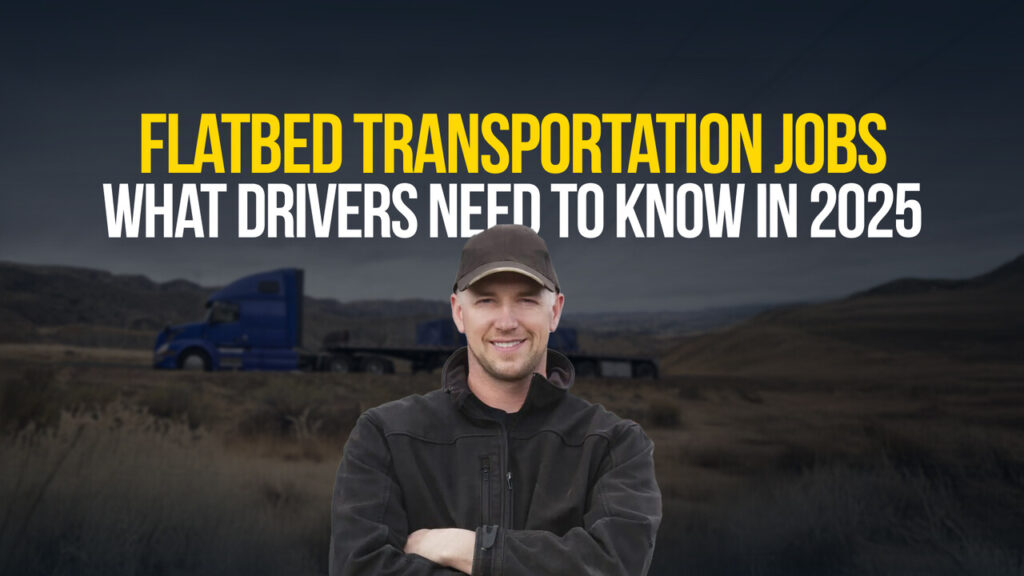
Flatbed transportation jobs are more than just another CDL-A career path—they offer a unique blend of challenge, variety, and high earning potential. For many truckers, flatbed hauling is a chance to level up their skills, increase income, and enjoy more physical activity than standard van or reefer jobs. In this post, we’ll break down everything you need to know about flatbed trucking jobs in 2025, including job requirements, salary expectations, and how to find the right fit for your lifestyle.
Why Flatbed Trucking Jobs Are in Demand
The demand for flatbed transportation jobs continues to rise, especially as industries like construction, manufacturing, and energy remain strong. Flatbed drivers are responsible for hauling freight that doesn’t fit inside a standard trailer—think steel beams, lumber, heavy machinery, or oversized equipment.
Key drivers of demand include:
- Increased infrastructure spending across the U.S.
- A shortage of experienced flatbed drivers
- The need for specialized securement and safety skills
According to the Bureau of Labor Statistics, trucking jobs are projected to grow steadily through the decade, with flatbed roles offering more niche opportunities for drivers willing to go the extra mile.
What Makes Flatbed Jobs Unique?
Flatbed trucking isn’t for everyone—but for the right driver, it’s a rewarding career path. Here’s what sets flatbed apart:
Physical Work and Securement
Drivers must manually secure loads using chains, tarps, or straps. This means:
- More physical activity (great if you don’t want to sit all day)
- Additional training on safety and securement best practices
Weather Exposure
Unlike dry van freight, flatbed loads are open to the elements. You may have to secure or tarp loads in rain, wind, or heat.
Versatility of Freight
No two hauls are the same. Flatbed drivers often carry different types of freight each week, adding variety to their routine.
How Much Do Flatbed Truck Drivers Make?
Flatbed trucking jobs typically pay more than standard CDL-A positions because of the added labor and risk. In 2025, flatbed drivers can expect:
- $70,000–$95,000 annually for company drivers
- $100,000+ for experienced owner-operators
- Accessorial pay for tarping, extra stops, and securement time
Some carriers even offer weekly minimum pay guarantees or performance-based bonuses to keep flatbed drivers motivated and retained.
Best Carriers for Flatbed Transportation Jobs
If you’re looking for flatbed roles that match your lifestyle, look for companies that prioritize:
- Training and safety support for load securement
- Transparent job descriptions with lifestyle details (regional vs. OTR)
- Consistent freight lanes and predictable schedules
👉 Drivers 1st offers matches flatbed opportunities to your preferred home time, region, and equipment. Search Flatbed Jobs Now
Getting Started in Flatbed Trucking
Even if you’re new to flatbed, many companies provide paid securement training or hire new drivers with minimal flatbed experience. Here’s how to get started:
- Earn your CDL-A license
- Take flatbed-specific training
- Start with a mentor or ride-along program
- Work with a recruiter who understands your goals
Looking to make the switch from dry van or reefer? Talk to a Drivers 1st Advocate to explore how flatbed can fit your next career move.
Conclusion: Is Flatbed Right for You?
Flatbed transportation jobs are ideal for drivers who want variety, don’t mind physical work, and are looking for a higher pay ceiling. With the right carrier and support system, flatbed trucking can be a fulfilling long-term path in the industry.
Ready to roll?
👉 Talk to a Driver Advocate or Search CDL Flatbed Jobs now.
For more updates and insights into the trucking world, stay tuned to Drivers1st.com!